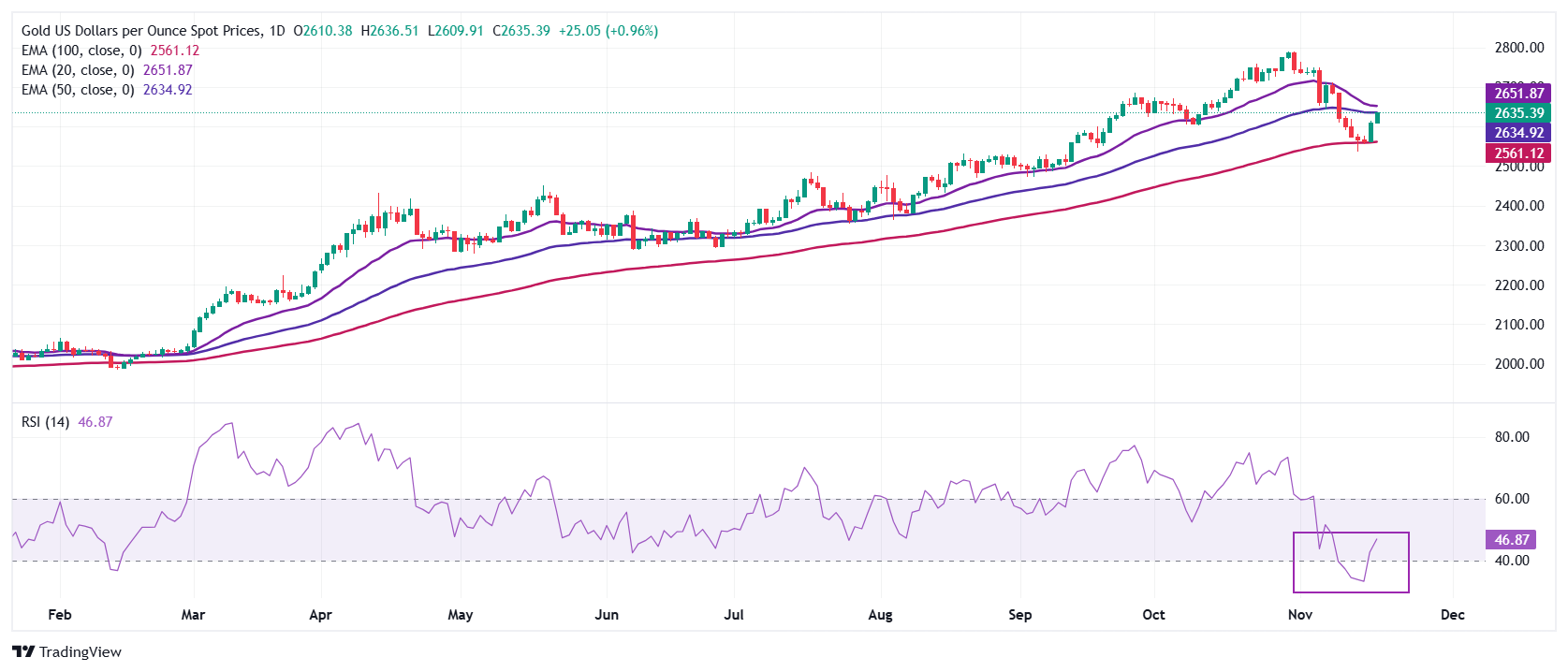Gold strengthens as Russia changes nuclear doctrine
- Gold price recovers further to nearly $2,635 on the fresh escalation in the war between Russia and Ukraine.
- Vladimir Putin has signed a decree to update the country’s nuclear doctrine.
- Fed officials refrain from forecasting the impact of Trump’s policies on the economy.
Gold price (XAU/USD) extends its recovery for a second consecutive day, trading around $2,635 in European hours on Tuesday, as Ukraine has already launched US-made ATACMS ballistic missiles into Russia, according to reports from local media RBC citing a source from the Ukrainian Armed Forces. The move has escalated fears of a nuclear war, prompting investors to flee towards safe-haven assets such as Gold.
Fears of an escalation in geopolitical tensions were already high after Russian President Vladimir Putin’s approval of the country’s nuclear policy revision, which appeared to be an answer to the US for backing Ukraine’s military strength by allowing Kyiv to use Washington-supplied ATACMS missiles to attack Russia’s Kursk region.
The nuclear doctrine "concerns the fact that the Russian Federation reserves the right to use nuclear weapons in the event of aggression with the use of conventional weapons against it" where that is deemed to have created "a critical threat to sovereignty or territorial integrity,” Dmitry Peskov, Press Secretary of the President of the Russian Federation, told TASS on Tuesday.
Peskov also stated that Russia acknowledges US President Joe Biden’s approval of the supply of missiles to Ukraine as an intent to prolong the conflict.
Historically, the safe-haven appeal of precious metals such as Gold increases at times of uncertainty or heightened geopolitical risks.
Leading investment banking firm Goldman Sachs is bullish on the Gold price for a year-long horizon and sees it rising to $3,000 by 2025 on multiple tailwinds. “The structural driver of the forecast is higher demand from central banks, while a cyclical lift would come from flows to exchange-traded funds as the Federal Reserve cuts (interest rates).”
Daily digest market movers: Gold price recovers sharply after plunging last fortnight
- Gold price has recovered almost 38% of the losses seen in the first half of November amid increasing geopolitical worries. The precious metal faced an intense sell-off as the US Dollar (USD) and bond yields strengthened on expectations that changes in fiscal and external policies promised by President-elected Donald Trump in his election campaign would be implemented smoothly, given his victory in both houses.
- Trump has vowed to raise import tariffs by 10% universally and lower taxes. This scenario is expected to boost inflation and economic growth, which could result in slower and fewer interest rate cuts by the Federal Reserve (Fed). However, Fed officials, including Chair Jerome Powell, have avoided commenting on the possible repercussions of Trump’s policies on the economy.
- The impact of Trump’s victory is visible in market expectations for the Fed's interest rate path. According to analysts at Nomura, the Fed is expected to leave interest rates unchanged in the December meeting. "We currently expect tariffs will drive realized inflation higher by the summer, and risks are skewed towards an earlier and more prolonged pause,” analysts at Nomura said.
- At the press time, the US Dollar Index (DXY), which tracks the Greenback’s value against six major currencies, rebounds from 106.10 as a fresh escalation in the Russia-Ukraine war has dampened investors’ risk appetite.
Technical Analysis: Gold price rebounds to near 50-day EMA

Gold price bounces back strongly after discovering support near the 100-day Exponential Moving Average around $2,535. The precious metal has recovered to near the 50-day Exponential Moving Average (EMA) around $2,635.
The 14-day Relative Strength Index (RSI) has rebounded above 40.00, suggesting that the bearish momentum is over.
Going up, the 20-day EMA around $2,650 will be a key barrier to the Gold price bulls. On the downside, the 100-day EMA will be a major support.
Gold FAQs
Gold has played a key role in human’s history as it has been widely used as a store of value and medium of exchange. Currently, apart from its shine and usage for jewelry, the precious metal is widely seen as a safe-haven asset, meaning that it is considered a good investment during turbulent times. Gold is also widely seen as a hedge against inflation and against depreciating currencies as it doesn’t rely on any specific issuer or government.
Central banks are the biggest Gold holders. In their aim to support their currencies in turbulent times, central banks tend to diversify their reserves and buy Gold to improve the perceived strength of the economy and the currency. High Gold reserves can be a source of trust for a country’s solvency. Central banks added 1,136 tonnes of Gold worth around $70 billion to their reserves in 2022, according to data from the World Gold Council. This is the highest yearly purchase since records began. Central banks from emerging economies such as China, India and Turkey are quickly increasing their Gold reserves.
Gold has an inverse correlation with the US Dollar and US Treasuries, which are both major reserve and safe-haven assets. When the Dollar depreciates, Gold tends to rise, enabling investors and central banks to diversify their assets in turbulent times. Gold is also inversely correlated with risk assets. A rally in the stock market tends to weaken Gold price, while sell-offs in riskier markets tend to favor the precious metal.
The price can move due to a wide range of factors. Geopolitical instability or fears of a deep recession can quickly make Gold price escalate due to its safe-haven status. As a yield-less asset, Gold tends to rise with lower interest rates, while higher cost of money usually weighs down on the yellow metal. Still, most moves depend on how the US Dollar (USD) behaves as the asset is priced in dollars (XAU/USD). A strong Dollar tends to keep the price of Gold controlled, whereas a weaker Dollar is likely to push Gold prices up.

